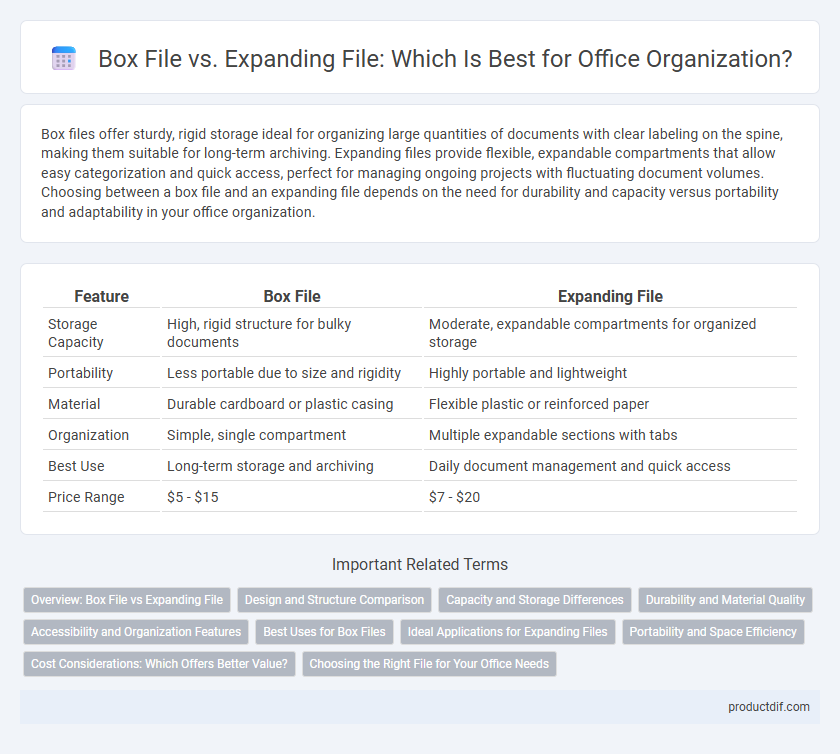Box files offer sturdy, rigid storage ideal for organizing large quantities of documents with clear labeling on the spine, making them suitable for long-term archiving. Expanding files provide flexible, expandable compartments that allow easy categorization and quick access, perfect for managing ongoing projects with fluctuating document volumes. Choosing between a box file and an expanding file depends on the need for durability and capacity versus portability and adaptability in your office organization.
Table of Comparison
| Feature | Box File | Expanding File |
|---|---|---|
| Storage Capacity | High, rigid structure for bulky documents | Moderate, expandable compartments for organized storage |
| Portability | Less portable due to size and rigidity | Highly portable and lightweight |
| Material | Durable cardboard or plastic casing | Flexible plastic or reinforced paper |
| Organization | Simple, single compartment | Multiple expandable sections with tabs |
| Best Use | Long-term storage and archiving | Daily document management and quick access |
| Price Range | $5 - $15 | $7 - $20 |
Overview: Box File vs Expanding File
Box files offer sturdy storage with a rigid spine and cover, ideal for organizing and protecting loose documents in offices. Expanding files feature multiple expandable compartments that accommodate varying document thicknesses and enable easy categorization. Both solutions enhance document management efficiency, with box files suited for long-term storage and expanding files optimized for portable, quick access.
Design and Structure Comparison
Box files feature rigid, sturdy covers and a spine for secure document storage, ideal for archival purposes, while expanding files offer flexible accordion-style compartments designed for sorting and quick access to documents. The structured design of box files provides enhanced protection against damage and easier stacking, whereas expanding files prioritize portability with lightweight materials and expandable sections. Both serve unique organizational functions, with box files excelling in long-term storage and expanding files optimized for dynamic filing and frequent document retrieval.
Capacity and Storage Differences
Box files typically offer higher capacity for storing large volumes of documents, accommodating up to 500 sheets or more with sturdy spines for organized filing. Expanding files provide flexible storage with multiple accordion-style pockets, ideal for sorting smaller amounts of papers and receipts while maintaining compact portability. Choosing between these depends on whether long-term storage or convenient sectional organization is prioritized.
Durability and Material Quality
Box files are typically made from rigid cardboard or plastic with reinforced edges, offering superior durability and protection for heavy documents, making them ideal for long-term storage. Expanding files, constructed from reinforced fabric or heavy-duty plastic, provide flexible compartments but may wear out faster under frequent use due to their foldable design. Choosing between these office supplies depends on the need for robust material quality versus adaptable storage capacity.
Accessibility and Organization Features
Box files offer sturdy, stackable storage ideal for organizing large volumes of documents with labeled spines for easy retrieval. Expanding files provide flexible, portable compartments designed to separate and access documents quickly, often featuring tabbed dividers for enhanced organization. Both solutions improve office efficiency but cater to different needs: box files suit permanent storage, while expanding files support on-the-go document management.
Best Uses for Box Files
Box files are ideal for organizing and storing large volumes of documents that need to be kept flat and easily accessible, such as client records, important contracts, or archival papers. Their sturdy structure provides excellent protection against damage and makes them suitable for long-term storage in office environments. Box files also facilitate quick identification and retrieval thanks to their wide spines that accommodate clear labeling.
Ideal Applications for Expanding Files
Expanding files are ideal for organizing and transporting large volumes of documents that require frequent access and categorization, such as client files, project reports, and invoices. Their flexible accordion-style design allows for easy expansion and separation of multiple sections, making them perfect for dynamic office environments where document volume fluctuates. Compared to box files, expanding files offer greater portability and quick retrieval, enhancing productivity in busy administrative and professional settings.
Portability and Space Efficiency
Box files offer sturdy protection and stack easily, making them ideal for stationary storage but less convenient for portability due to their rigid structure. Expanding files feature multiple flexible compartments that compress for compact storage, enhancing space efficiency and allowing easy transport between locations. Choosing expanding files supports a mobile workstyle with better organization in limited spaces, while box files suit permanent office setups requiring archival stability.
Cost Considerations: Which Offers Better Value?
Box files generally offer a lower upfront cost due to their simple construction and widespread availability, making them an economical choice for basic document storage. Expanding files, while often more expensive initially, provide enhanced capacity and organization features that can reduce the need for multiple storage units, potentially delivering better long-term value. Evaluating the total cost of ownership, including durability and storage needs, is essential to determine which option offers superior cost-effectiveness for office supply management.
Choosing the Right File for Your Office Needs
Choosing the right file for your office needs depends on storage capacity and organization style; box files offer sturdy, vertical storage ideal for thick documents, while expanding files provide flexible, compartmentalized sections for categorizing multiple smaller papers. Box files are durable and stackable, suitable for archive or project folders, whereas expanding files excel at portability and quick access to frequently used documents. Prioritizing document volume and ease of retrieval ensures efficient office management and optimized workspace.
Box file vs Expanding file Infographic

 productdif.com
productdif.com